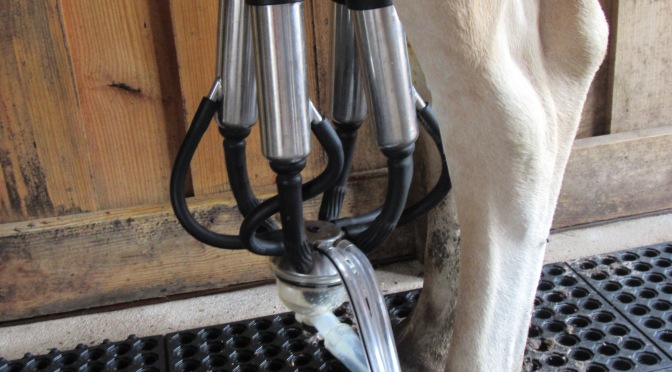In respect to my fellow FarmHers I am compelled to preface this article by making a statement: I do things the way I do things based on my own research, beliefs and spiritual journey. For me, this is the right way–for you, it may not be. I respect that. If your way works for you and your animal, stick with it, sister ! You will get no argument from me. The sharing I do here is to be helpful only. I share in this blog my mistakes and triumphs in hopes that it will benefit others in some way. If you take something from my sharing, it is a blessing to me. If you can share something that may enrich my knowledge in some way or improve my practices, please do. The following article is a sharing of my own ‘ hows ‘ & ‘ whys’ of training to the stanchion. Nothing more. Nothing less.
I started out with farming with one key mandate in mind; if I could not attend the global well being of my livestock I would be done with keeping animals. I believe with conviction in the necessity of acknowledging the psychological and spiritual needs of an animal as well as their nutritional and housing requirements .
All creatures capable of thought have ‘ feelings ‘. Period. All beings capable of thought have preferences, desires, individual personalities and psychological histories that make them ‘ who ‘ they are. There have been extensive controlled studies on the matter by respected entities. It has been found that across the plane of the animal kingdom, there exists a network of behaviors akin to human behaviors; nuances of emotions and cognition, patterns and paradigms , social norms and rules exist in the animal world that mimic our own. If you doubt that, I challenge you to park yourself among a herd of cattle and just observe.
Cows are skittish by nature. Let’s face it, although they are huge, potentially dangerous creatures, they really have few defenses when it comes down to it. They are subject to predators and are generally at our command. They are afforded few choices in life under normal circumstances and are subject to the will of their keeper. They know this. They are not dumb animals.
Cows are also creatures of habit. They thrive on strict routine and will line up in the same basic order for milking times and feed times. They choose and flock to their favorite shade and resting areas. They have individual preferences for troughs , barns and hay rings. They find comfort in doing things the same way on the same schedules every single day. When there is upset to their routines or changes in their environment, it is very stressful and frightening to them.
Cows do not like confinement, spaces they cannot turn around in or loud , sudden noises. They do not like walking into dimly lit spaces or through small doors. Seeing things that are out of place such as even a bucket they do not recognize makes them nervous.
Those simple facts being stated, imagine if you will that you are a cow who has just given birth. Your farmer now asks you to leave your newborn baby and come into a room you have never been in, through what is basically a human sized opening and is not very well lit. Inside this room you have heard strange, loud noises if there is a milk machine. You have no idea what is about to happen to you. You resist. Of course.
Your farmer forces you in and locks your head in a strange contraption that you cannot escape from. You can’t free yourself or back out.Then, she tries to take your baby’s nutrition from your udder . Your baby needs that ! You resist some more. You are being restrained and handled in the most personal and in your view, inappropriate ways. You are fighting against things you have never experienced in a strange room , locked in by your head and you’re scared and you don’t know even where your baby is or what is happening to him/her. You’re probably a little angry too !
I have seen ” trained ” dairy cows that are absolutely horrified of the stanchion and must be manhandled to get them in , then restrained with all manner of devices just to get them milked; this is not psychologically, nor physically healthy. Temple Grandin suggests that one can tell how stressed a cow is by the number and tone of her moos; this is true. If a cow is constantly mooing in a low distressed way or hollering and thrashing in the stanchion, on my farm that means that training is going badly and the session ends. I instantly release her. There is a vast difference between a cow working out in her mind what is going on with normal resistance and thrashing about in obvious duress– Normal stress is not long-lasting and/or violent; once the cow realizes no harm will come to her, she settles and you can move forward. My rule of thumb is that there must be an obvious progression of acceptance–a minimizing of the displays of distress, if you will, for me to continue.
A commonly recommended resource for folks starting out with dairy cows is ‘ Keeping a Family Cow ‘ by Joann S. Grohman . It has become the Bible for homesteaders and small farmers starting a dairy herd or just having a single family milk cow of their own. While it is an invaluable resource and packed full of incredibly useful information and tips, I find many of her opinions in direct contradiction with my personal experiences and observations: ie..” Cows don’t like dogs. They are natural enemies ” ( Chapter 3: A calm environment) I have multiple photos of my dogs lying in service of my cows as they give birth, protecting both the dam and her arriving calf, licking the face of the dam completely accepted as part of the process. My cows will sleep next to my dogs and my dogs often sit in the parlor with me. I call my three Great Pyrenees ‘ The Cowboys ‘. Again, it goes to personality, training and preference–of the cow, the dog, the farmer. A well trained farm dog is a part of the herd, accepted by the cows. If you have a cow who comes from a farm where dogs were allowed to nip at her heels in the process of herding, of course she will dislike your dogs. I have one such cow here. After ten months of my redirection and training of her , she no longer charges my Pyrenees, although she still regards them with suspicion and probably always will. When one says ” cows don’t like dogs ” , it is akin to saying cats don’t like dogs; it may be the rule of the wild and commonplace on farms where dogs are permitted and/or encouraged to bite at the heels of a cow, but on a gentle & humane farm, a bovine is not wild, nor is a properly trained and respectful dog.


I disagree with some of Ms. Grohman’s methods when it comes to training as well. She openly admits to and endorses scolding a cow who {misbehaves} in the stanchion by yelling at the cow and manhandling her: ” grab her leg and firmly pull it down ” ” I yell at her ” , which seems in direct contradiction to her stated practices elsewhere in her book of getting into the right mindset by ‘thinking positively’. She also recommends such things in situations with cows that kick the bucket while in training as lashing their legs by going under the belly in front of the udder with ropes , reminding the reader that this is dangerous and the ropes must be loosened frequently so as not to damage the udder or disrupt circulation and tying the cow’s tail to her leg to prevent her smacking you with it if she insists on doing so ( Both found in Chapter 3: ‘Milking your Cow’ in the section devoted to ‘ kicking ‘ ). I disagree with the practice or necessity of any of these suggestions.
To the matter of kicking, a kick stop device will prevent that without the great risk or stress of yelling, grabbing, tying or pulling on your cow. Ms. Grohman even recommends them and illustrates them. I cannot fathom why she chose to include the dangerous and stressful options. To the matter of tail flicking, that usually passes quickly:it’s part of the training process for the cow to use whatever means she has at her disposal to air her disapproval, although a bothersome fly now and again may get you an unexpected smack across the face. It happens. I wouldn’t tie my girl’s tail on the off chance it might. As to yelling at my cows–I don’t do it, just like I don’t yell at my grandson. It isn’t necessary to yell to correct a child and it isn’t necessary to yell to correct an animal who is restrained in a stanchion. If a cow is barreling at me full speed and about to mow over me– heck yeah ! I yell !
I introduce my bovines in training to the parlor PRIOR to their calving. I simply spend a couple of minutes each time I am in the parlor inviting them in for a small scoop of grain and getting them used to the goings on. Seriously, a couple of minutes. It doesn’t have to be every time either. I just make an effort when I can. If they choose not to come in for the grain, I simply shut the door and leave. Eventually, they come in.
Also, realize as you go through these steps, sometimes you will accomplish only one a day with a certain cow, while with others you will fly through several in the same day and then stall on one. Each cow is different as is each human. I do not pull my calves from their dams, so this affords me the time to work with them at leisure and not be hurried through training post calving either. Despite what is commonly believed, it is not necessary to fully milk out your first freshener heifer in the first 24 hours. She will not get mastitis and it will not make her less of a producer to introduce her to milking more patiently if she retains her calf. It can take a couple of days for her milk to even come in: In fact, licensed dairies are required to withhold milk from a freshening cow for 3-4 days to ensure it is free of colostrum residues. Sidenote: if your heifer / cow is suffering from edema or is a very heavy producer it is in her best interest for the sake of her health and comfort to milk her out as quickly as possible. –If she is familiar with the stanchion and processes, this will be an easier task to accomplish within the first 24 hours even if you have never milked a cow before.
There have been extensive scientific studies done at reputable university programs which have proven that if a cow is under stress or discomfort ( physical or psychological) , her productivity in the parlor suffers. Her global comfort during the milking process from day one is in everyone’s best interest.
By the time my expectant heifers have calved, I have gone through all of the possible steps to familiarize them with the parlor ; Coming in has become second nature to them. I accomplish this in under 5 minutes a day within a couple of weeks and as I stated, it doesn’t have to be every day. Bringing a first freshener heifer in ‘ cold ‘is common practice and I did it myself when I first started with dairy cows , but as I grew as a keeper of cows I learned and as I learned, I changed my way of thinking. I no longer practice ‘ cold training ‘ as a result of the things I have witnessed and feel unnecessary, unkind and unproductive.
I used to ascribe to the theory that since training without introduction was ‘ The Norm ‘ it was the best way and that since my bovines hung around and saw what was going on they would be somewhat familiar anyhow–then I realized, no matter how many times I watch a new, intimidating experience , it isn’t until I actually try it and learn the process that I become comfortable and I don’t usually want to be immersed in it all at once but introduced with respect to my ability to handle things. I asked questions of professionals in every aspect of the field and I read every reputable resource and study I could find and developed a kinder, more gentle , respectful system that works for me and my cows. Every single time.
This method will work regardless to how you intend to milk your cow: by hand or machine, in stanchion or freestanding with halter.

Transitioning an older cow from ‘ Nurse cow ‘ to ‘ Family cow ‘
Ella is a 5 year old Jersey who has never been milked. She was sold to me being described as a cow who had always delivered ” on pasture “. She was not a pet. Ella was a well kept girl who had just not been acquainted at all with the life of a dairy cow.
My first step in such a case is just to acquaint them to the parlor. I feel that especially with an older girl it takes a little preparation and patience to transition her from being a ‘ nurse cow ‘ to a ‘ milk cow ‘ and maintain the trust and stress free environment I demand.
I introduce slowly, step by step and begin the morning after they arrive.
Step 1 : Just get her to come in on her own for some grain.
So far, she’s done a lot of peeking. lol
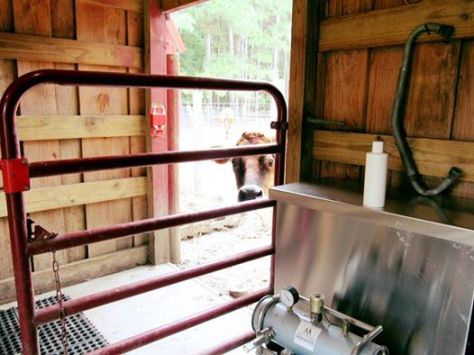
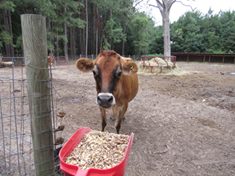
Eventually, the draw and promise of the grain will prove too much and she will come in.
She came in that afternoon–the afternoon following her arrival. I only tried twice.
Step 2: Just let her enjoy her grain, undisturbed, head gate open or untied if you are using a halter.
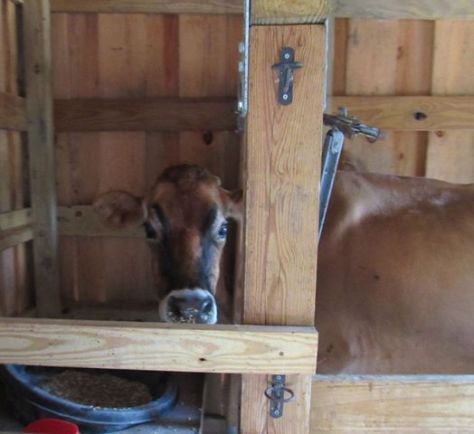
At this point, I call it a successful day even if it’s morning. I never want to overload them and have to start from square one because i freaked them out and she went back to refusing to come in.
Step 3 : close the head catch ior secure your lead if using halter. If the cow is calm, move to step 4.
Ella was not calm. She needed to work through the idea of the head catch. It is really important that they work through and relax completely ( ie..eating grain again ) before releasing them and that this is ALL they are dealing with at this stage. If you release a cow while she is struggling, it is tantamount to telling her that if she fights, she will break free. Never release a cow while she is struggling unless it is a matter of her safety.
I like them to realize that being restrained does not equate to something unpleasant in the parlor. Restraint usually equals some form of care or vetting a cow is not fond of. My opinion is that a 5 year old cow who has never experienced milking before is going to have a much harder time psychologically absorbing what is going on and will have a higher level of stress and/or fear than a heifer who has not had as many life experiences. That is why I prefer to acquaint them slowly and with respect to their feelings at this age.
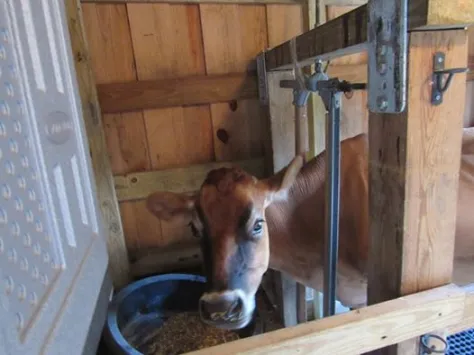
Step 4: Handle her while in head catch or while secured with lead.
Many nurse cows have been on pasture and are not accustomed to being handled. The simple act of handling a cow extensively such as is required with milking is very stressful and alien to them. I start by scratching her head and face gently as she is eating. If she pulls away, do the same and reintroduce the petting when she turns her attention back to the grain. Touching her face accomplishes two things: it introduces her to your touch in a direct manner and it gets her used to being in close proximity with you.
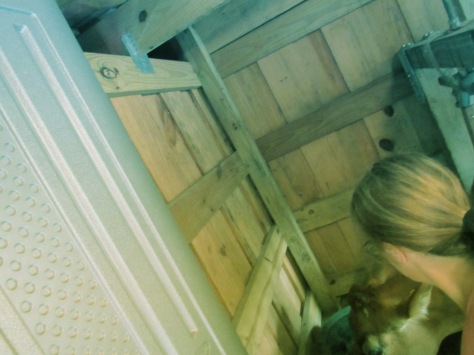
As she assimilates to accepting that touch, I move to her back and run my hand lightly along her spine and ribs, talking gentle reassurances as I do. Again, pulling away if she shows signs of stress. It may take two or three sessions of this to get to the point where you can handle her without complaint or fear.
*DO NOT stand directly behind or in the line of side swipes from her hooves as you handle her if she is not accustomed to touch as you move through this process*
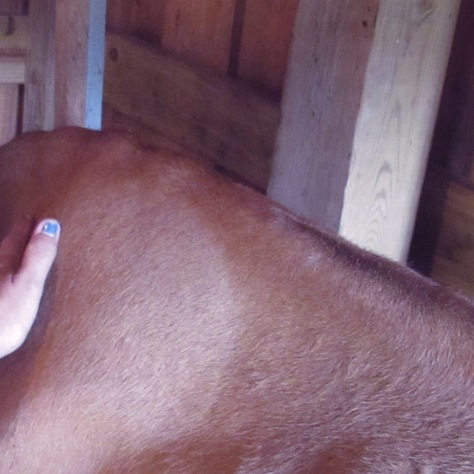
I DO NOT touch her udder at this point. That may earn you a swift and dangerous kick at this early stage. It is my belief through research and observation that the udder is the most personal place one can touch a cow after she calves. I reserve that touch for when I actually intend to milk her. That’s an ALL IN touch in the bovine world.
Lastly in introducing touch, I open the stanchion or release her tie off once she comfortable with my petting before she finishes her grain and continue to run my hand across her back. There will be times in milking your new cow that you must handle them without restraint. I don’t want them to think the only time they will be touched is when they have no choice in the matter. Not all dairy cows are ‘ pets ‘, even on the smallest of farms. I also make it a point to pat her backside and give her a ” good girl ” each time she leaves the parlor. For safety’s sake, always walk out to one side or the other of your cow, never directly behind her.
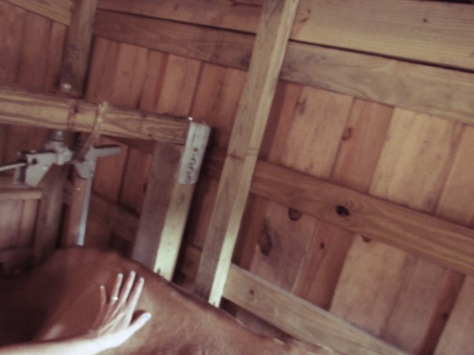
Step 5 : introducing any further restraint or kick you intend to employ.
( I no longer use restraints unless I have a freaky natured or dangerous tempered cow on my hands, but did with every first milker when I was new to training to keep myself safe until I was comfortable with the process. )
Always secure your cow first.
If you intend to use a kick stop bar or additional restraint to the head catch, this is the time to employ that introduction. Do your measurements with the bar using the holes on the outsides of the apparatus prior to putting on the cow after she is in the stanchion by holding beside her.
Most have push button adjusting holes on the top and bottom to fit perfectly under the skin around the cow’s lower flank and over the cow’s spine at the hip area. The bar should fit snug enough not to slide much and fall off, but not too tightly to be uncomfortable or pinch and pull. I have made the mistake of having it too loose and had it fall on my head as I put on the milking head of the machine. It’s heavy metal. It hurts if it hits your head and leaves a goose egg.
There are two basic types of anti -kick devices on the general market: one -sided and two-sided. Both are pictured below. Choose the one that best suits your needs. I find that the two-sided devices do not fit the smaller stature cows well as they are designed with larger bovines in mind and although they are adjustable, the arch does not sit well on the small stature or miniature Jerseys. The ‘ pinscher ‘ type design sits better on standard sized cows, but is hard to manipulate with my small hands and arthritis. I use the single sided, adjustable kick stop.
The two most important things to remember when using an anti-kick device of any kind on your cow are as follows: ALWAYS remove the device BEFORE you release the cow . Serious and often irreversible injury occurs when a cow is set out with the device in place and begins to jump around and flail when she cannot properly move around in it. Secondly, always adjust the kick-stop device properly to your cow for safety and comfort–yours and the cow’s. If too tight, it can disrupt circulation to the cow’s leg or udder, if too loose it can create a situation where you or the cow may become injured by the tool.
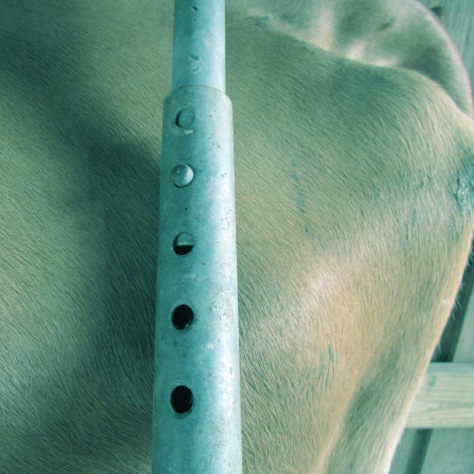
So, for this step, just get your girl secured and employ the kick devise. Handle her gently and talk to her. Let her eat her grain. Remove the kick device first, then release her.
I leave it at that for the day but usually try to do it both milking times; getting accustomed to restraints is a lot to bear.
Step 6 : The sounds of the parlor
The next time I bring her in I have the milk machine ready to turn on whether i am milking anyone else of not. It is sitting in it’s proper place so she sees it when she comes to the entry way. Usually, this will be enough to stop a cow in her tracks. It is a new object in her sight. She may back away, approach it with caution and sniff it before deciding to come in. She may even decide not to come in. Sometimes seeing a new thing in the parlor is a deal breaker even for a seasoned cow. Be patient. If necessary, show her a scoop of grain and start coaxing her in again just like in the beginning. If she doesn’t come in the time you need her to, close the door and come back later just like before. She’ll come eventually.
If you don’t use a machine, put out your stool, your wagon, whatever you use in your milking chores that would normally be in or near your parlor in it’s designated place. While she is in the stanchion move about the parlor making the usual movements and noise you would create while going through the motions. It is not necessary to exaggerate these noises or movements, to acquaint her with the normal activities of milking time is the goal.
Once in the stanchion, go through your necessary steps to prepare her and make her ( and you ) comfortable and safe because this time you will turn on the machine. The noise of the machine sends some cows into convulsions. Some don’t care at all. If she doesn’t seem to mind the machine, go to step 6.

Step 6 : Hand milk your cow
I recommend hand milking your older cow the first time whether you intend to use a machine or not. This helps her transition to a family dairy cow more easily by introducing the idea of being milked from a gentler perspective.
If you are using restraints, make sure they are secure. Make certain your cow has sufficient grain in her stanchion. Get your bucket and udder supplies.
Gently run your hand down the cow’s side to the udder and let her know your intention. Clean the udder. Begin to hand milk your cow. Do this while being as quiet and subtle with your movements as possible , praising her if you like. The idea is not to fully milk her out this first go , but to get her used to having her udder manipulated and hearing the machine at the same time. If she tolerates the milking process well, go ahead and milk her out. If she is thoroughly resistant, I milk her with frequent breaks as needed for her safety and mine for a short period of time. After I have milked the first time if she’s calm ( always wait for her to settle before moving on) I remove all restraints, turn the machine off , pet her a bit , then release her, allowing her to finish her grain unrestrained and in peace.
*If she takes to being milked by hand well, the next time you milk introduce your machine if you intend to use one–even if it is the same day; If you hand milk in the morning and normally do an afternoon milking, use the machine in the afternoon.*

I always walk out with my cow until they know the routine, even though the parlor has a corral that leads right out to the cow yards. It reinforces the idea that I am leading the show and that I have their best interests at heart and will always return them to the herd.

Step 7: Use your machine or fully milk your cow.
Go through your necessary steps to secure and prepare your cow for milking.
Once ready, turn on your machine or get to milking. I find that doing this without hesitation or explanation at this stage is the best way. She has already been introduced to all the different aspects and is familiar with all of the components of being milked and every sight and sound and sensation that it entails aside from having a machine put on her. If you’re using a machine , the only way to introduce that milking head is to go ‘ all in ‘ and put it on her. She likely won’t appreciate it, but my experience has been that the comfort you have provided by preparing her mind for all that is going on aside from that one experience will temper her reaction and recovery time. With this particular girl, the mental preparation I afforded her through this gentle introduction combined with her accepting nature made it a very stress free procedure for both of us. These are actual photos of her first machine application; no kick – stop device , no drama. This was only four days into her training and the fifth day of her residency here. ‘ Nurse cow ‘ to fully trained and contented ‘ dairy cow ‘ in about 80 minutes total time invested: 10 minutes or less twice daily for 4 days.
The differences in training an older cow and a first freshener for me would be subtle:
- I would introduce the first freshener along and along to the parlor through the last stages of her pregnancy when the opportunity presented itself–ie…she was near the parlor door, or I had the time to coax her in.
- I would go through as many of the steps as possible while she ate a tiny bit of grain each time she progressed through one, moving to the next: including working my way up to handling her udder and eventually even cleaning it.
- I would milk her out completely her first post-calving time by hand and even possibly, if she fully accepted the hand milking, switch to machine during the first milking.
A first freshener under my training will have a lot of time in the parlor under her belt already in small intervals and would, therefore, fly through most of the latter steps of her post-calving training fairly quickly without much incident. There are exceptions to the rule; I had one spoiled rotten heifer who was very comfortable in the parlor / stanchion and with being handled but was determined to take my head off no matter what when it came to having the machine applied. Her training to the machine ended up taking a couple of weeks although she was 100% accepting of hand-milking. I’ve seen that happen with ‘ cold trained ‘ heifers as well and with much more frequency. Indeed, it is only logical that a cow unfamiliar with the goings-on is more likely to have extended periods of resistance and stress, which has led me to devote myself to the gentler way of training. It is to the individual bovine how the training will progress, but if one removes most of the fear and stress factors from the cow herself, it stands to reason that it will only go more smoothly for both farmer and cow.
It is important to realize that there will almost always be some degree of resistance as your cow adjusts to the idea of each step. Learning the difference between normal resistance and high level fear / stress is key. Below are a few examples.
* When my cow is working through the normal indicators of adjustment to a process, I step back and let her deal with it as long as she progresses towards settling down *
Normal signs of resistance in the parlor:
- shifting weight in stanchion
- pulling back with moderate force and twisting head against head latch in stanchion
- kicking at hand with back hooves when touching udder
- swishing tail
- occasional low-tone moos
- looking around / trying to turn around
- moving head up and down in head catch / against tie-off
- smacking you with tail
- stomping feet
- temporary bucking ( brief and occasional )
- twisting head in stanchion
Abnormal signs of stress:
- loud continual mooing
- coughing or strangling sounds
- drooling / foaming
- sustained head thrashing against head latch ( lasts for more than 10 seconds is a good rule of thumb)
- trying to fall on floor
- twisting her entire body in attempts to get free
- ongoing bucking
- lack of focus ( wild eyed, horrified look )
- quivering and shaking
When I see any of these indications that the session has gone bad, I end the training. NEVER attempt to release a cow that is in a panic state !!! Always wait for her to settle !! Attempting to release her while she is in such a state could result in serious injuries to yourself or your cow !!! ( the only time I release a bovine in a dangerous state of mind is when she is in mortal danger: she has become entrapped or such and is at risk of serious injury.)
Releasing her in a panicked state of mind also ends your session on a poor note. You want her to know that when she is calm and cooperative, she will be released and that her time in the parlor ended well. Before resorting to releasing her, attempt to settle her by removing what set her off if possible. Also offer her comfort in the form of assurances and a favorite treat. Redirect her mind if possible.

This former pasture girl began to wait for me at the parlor gate when she saw me coming the very week she started her training. It took me only a few days days to train this girl in a completely stress-free way. She was sold to me as a cow who had always delivered on pasture and had not been handled. She now views the parlor as a place of peace and comfort, where she will receive grain and relief from her heavy udder. If training is done with patience, it will be for your girls too.
Resources: ( I could not possibly list all of my resources for this model, but these are a solid few )
- Understanding animal stress helps improve production efficiency (The Scientists tell me) by Marilyn Brown
- Keeping a family cow by Joann S. Grohman
- Behavioral Principals of Livestock Handling by Temple Grandin
- Animals Make us human by Temple Grandin
- Temple Grandin : How the girl who loved cows embraced autism and changed the world by Sy Montgomery
- Why and How to read a cow or bull : https://nature.berkeley.edu/ucce50/ag-labor/7article/article29.htm *( brief but good observation of bovine body language )*
- Using behaviour to assess animal welfare ( MS Dawkins 2004 )
- The Behaviour of Cattle by J. L. Albright
- Principles of Psychology by Marc Breedlove
